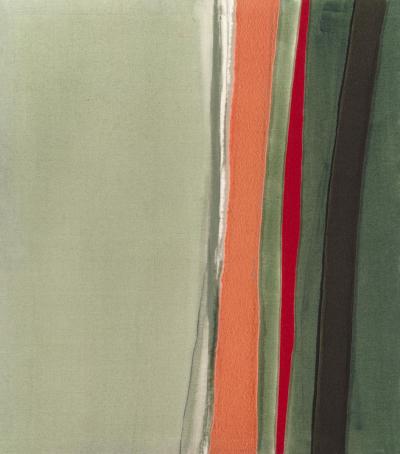Artist of the Month: December 2014
Artist of the Month: December 2014
Sandra Blow RA (1925 - 2006)
By The RA Collections Team
Published 8 December 2014
Sandra Blow RA created “thrilling harmonies” with bold colours and abstract compositions inspired by the Kent countryside and trips to Rome and St Ives.
-
“I have two equal sources of inspiration. One is art, first the Renaissance art I saw in Italy at the same time I saw the work of Alberto Burri and Nicolas Carone… and later African sculpture and, among other painters, Roger Hilton and Morris Louis. The second influence is nature. I marvel at the beauty and construction of the leaves and flowers outside the studio. I love London skies, because they are framed and one sees them almost like a painting.” (Sandra Blow)
Sandra Blow began to paint as a teenager when, during the war, she was evacuated from London to her grandparents’ fruit farm in Kent. The landscape was her first subject, and though she achieved fame as an abstract painter, the forms, colours and textures she encountered in nature remained a strong influence on her work for the rest of her career. By trial and error as much as intuition, she used washes of paint, texture, collage and bold gestures to achieve the “thrilling harmonies” she desired.
-

Sandra Blow RA photographed by James Hunkin, silver gelatin print, 2002

Sandra Blow RA, Green and Red Variations, 1978.
-
Blow studied in London and Rome, where she met Alberto Burri. His abstract paintings, often made using ‘poor’ materials such as sackcloth, were a formative influence on her art. However, she felt she had to return to London to find her own voice. In 1951 she took six paintings to Gimpel Fils in the back of a taxi and was promptly offered her first solo show.
She was a regular visitor to St Ives from 1957, when Roger Hilton, whose work she admired, invited her to visit him and introduced her to many of the other artists working there. Though she made many more working trips, for most of her career she preferred to paint in her Kensington Studio, using these visits as a way of “finding things outside and then bringing them back home in order to digest them and make something of my own of them.”
Successful and sociable, Blow joined the teaching staff of the Royal College of Art in 1961, became Associate of the Royal Academy in 1971 and a full Royal Academician 1979. She continued to paint and exhibit until her death in 2006.
See more works by Sandra Blow RA in our Collection.
-
As well as wanting a balance in the composition, there should be what I call a startling rightness. This can be any shape or colour: the crucial thing is that although perfect in its place, there is an unexpected quality about it, an element of surprise.
Sandra Blow RA





